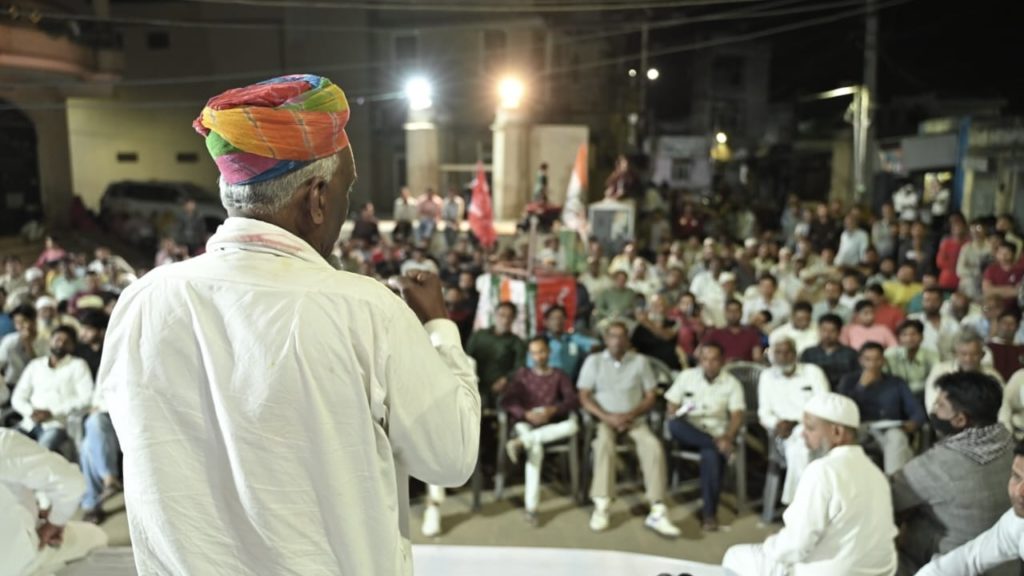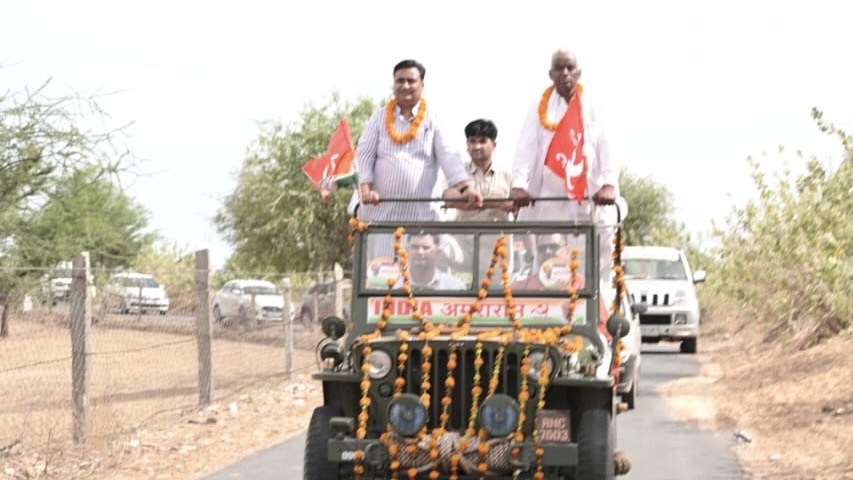The far-right government led by Narendra Modi and his Bharatiya Janata Party (BJP) was dealt a significant blow in India’s 2024 general elections. The BJP saw a dramatic decrease in its seats from 303 in 2019, to 240 in 2024, with the party unable to achieve parliamentary majority without its coalition partners.
The center-left alliance meanwhile, increased its coalition’s seats by 112. Despite winning only eight of the alliance’s seats, the left parties played a major role in this comeback through mass mobilization, agitation, and awareness raising campaigns ahead of the elections and in the last several years against the BJP government and its policies.
One of the major indicators of its central role in defense of the people and their rights, and a significant development for the future of left politics in India’s parliament, was the election of Amra Ram from Sikar, Rajasthan. The veteran of several major mass movements and the leader of All India Kisan Sabha (AIKS) is the first popularly elected MP from the left parties in northern India in more than two decades.
72-year-old Amra Ram is the secretary of Rajasthan state committee of the Communist Party of India (Marxist). He has been a prominent face of the left movement in the state with a record of leading large scale mobilizations against the government’s unjust policies in the region. One of the most significant struggles Ram helped lead was the 2017 farmers’ protests in Rajasthan, which saw tens of thousands of farmers and working class people take to the streets to demand a rollback of neoliberal austerity policies and better conditions for farmers. The massive mobilization forced the then BJP government in the state to give better prices for farm produce and loan waivers to farmers.
As leader of AIKS, Amra Ram played a major role in the year-long sit-in at one of the borders of Delhi (Shahjahanpur) during the farmers’ protests against three anti-farm laws proposed by Narendra Modi government in 2019-20.
Ram’s work organizing the masses dates to before the most recent round of agitation against the BJP government. In 1979, while a student in university, he was elected president of the student union under the banner of the Students Federation of India (SFI) and went on to be a four-time councilor, and a four-time member of state legislature or the legislative assembly (MLA) as it is called in India. He ran for a seat Lok Sabha seven times before finally getting elected at his eighth attempt this year.

In these elections, Amra Ram defeated two-time incumbent Sumedhanand Saraswati from the ruling, right-wing BJP by a margin of over 70,000 votes. Saraswati is a Hindu religious leader and has strong ties to prominent Hindu movements in the country.
Ram overcame the right-wing Hindu candidate due to his strong legacy of leading people’s movements in the region. The continued agitation and mobilizing for farmers and working class issues in the region has helped in creating a class consciousness which has made Shekhawati known as the “red fort” of Rajasthan.
93% of MPs are rupee billionaires – except those from the left
Days after the general election results were published, India’s Association of Democratic Reforms (ADR) released a report indicating that over 93% of the MPs that won in the 2024 elections are at least rupee billionaires with some having assets worth billions of dollars.
The MPs elected from the Left parties are part of the 7% outliers, yet represent the overwhelming majority of India’s population (around 86% of total population) which lives on less than USD 5.5 a day. Amra Ram has a declared worth of around four million rupees (less than USD 50,000) which includes the value of the land owned as well.
All of the elected parliamentarians from the left are trade union or farmer leaders, the core constituencies of the left movement in India. There are a total of eight MPs from three left parties elected in the India’s Lok Sabha in this year’s elections. Four of them are from CPI(M) and two each from Communist Party of India (CPI) and the Communist Party of India (Marxist-Leninist) Liberation – CPI(ML)L.
The other three CPI (M) MPs are K Radhakrishnan, SU Venkatesan, and Sachithanantham R. K Radhakrishan from Alathur, Kerala is the secretary of Dalit Soshan Mukti Manch (DSMM) an all India organization fighting for the rights of Dalits, socially and politically discriminated and economically deprived sections of the society. SU Venkatesan from Madurai, Tamil Nadu and Sachinthanantham R from Dindigul, Tamil Nadu are both veteran trade union leaders.
The two MPs from CPI are both trade union leaders. Selvaraj V is from Nagapattinam, Tamil Nadu and Subbarayan K is from Tirupur, Tamil Nadu, one of the world’s largest hubs for the clothing industry.
The CPI (ML)L MPs, Raja Ram Singh Kushwaha and Sudama Prasad, hail from the largely agrarian belts of Karakat and Aara in Bihar, one of India’s largest provinces in the east. CPI (ML) Liberation will be represented in the Indian parliament for the first time since 1989.
While the right-wing National Democratic Alliance (NDA) still holds a majority in the Lok Sabha, its weakened position means that it will face greater resistance both in parliament and on the streets when attempting to push forward its anti-democratic reforms and policies.





